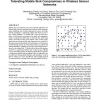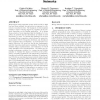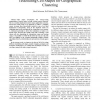474 search results - page 67 / 95 » In-Network Outlier Detection in Wireless Sensor Networks |
MOBIHOC
2005
ACM
14 years 7 months ago
2005
ACM
Mobile sinks are needed in many sensor network applications for efficient data collection, data querying, localized sensor reprogramming, identifying and revoking compromised sens...
WS
2006
ACM
14 years 1 months ago
2006
ACM
Wireless networks are vulnerable to many identity-based attacks in which a malicious device uses forged MAC addresses to masquerade as a specific client or to create multiple ill...
SENSYS
2003
ACM
14 years 1 months ago
2003
ACM
Event-driven sensor networks operate under an idle or light load and then suddenly become active in response to a detected or monitored event. The transport of event impulses is l...
IEEECIT
2010
IEEE
13 years 6 months ago
2010
IEEE
This paper investigates the energy-saving organization of sensor nodes in large wireless sensor networks. Due to a random deployment used in many application scenarios, much more n...
ICC
2008
IEEE
14 years 2 months ago
2008
IEEE
— Wireless Sensor Networks (WSNs) are generally used for harsh environments involving military surveillance, emergency response, and habitat monitoring. Due to severe resource co...



